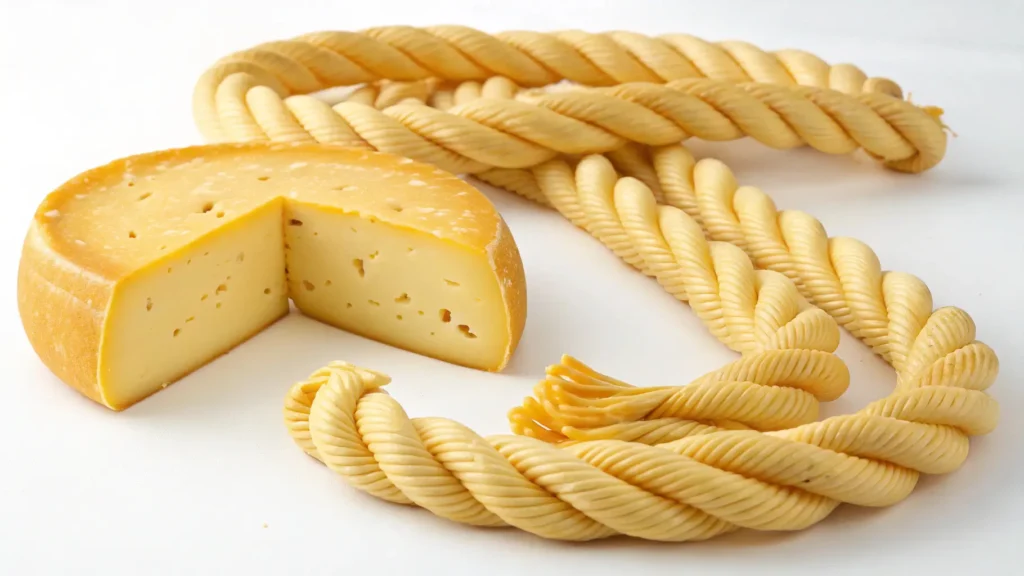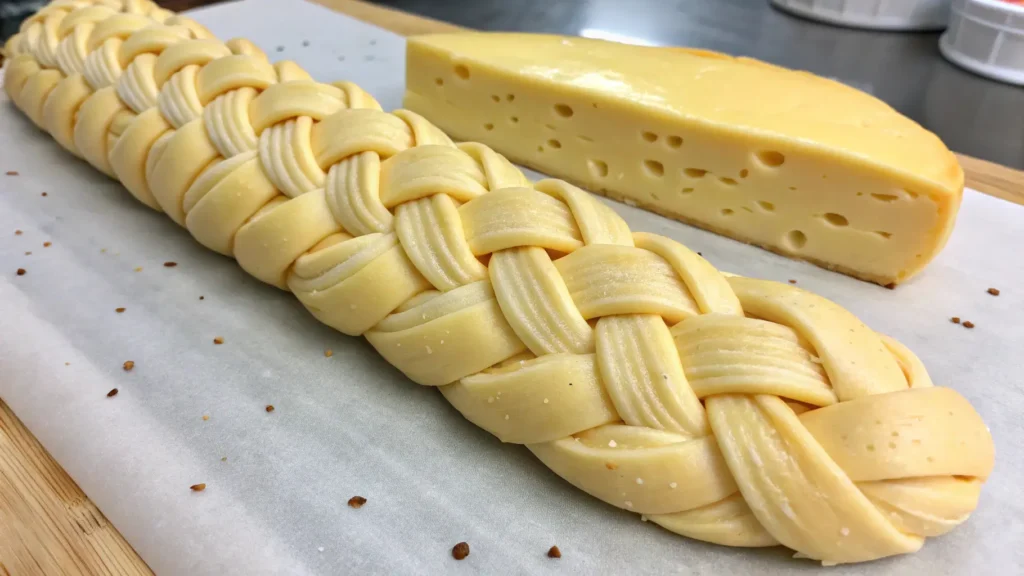Rope cheese, a stringy and delightful creation, has become a star in the world of culinary exploration. With its distinctive twisted appearance and intriguing texture, this cheese offers endless possibilities in the kitchen. In this article, we’ll delve into its history, unique characteristics, and production methods. You’ll also discover its nutritional benefits and creative ways to incorporate this versatile cheese into your meals. Join us as we unravel the story of this culinary twist on tradition!

Introduction to Rope Cheese
What is Rope Cheese?
Rope cheese, a variety of string cheese, earns its name from the twisted, rope-like form it takes. Crafted through a unique process of pulling and stretching the curds, it has a chewy, pliable texture that sets it apart from other cheeses. While it shares similarities with mozzarella, rope cheese stands out for its visual appeal and versatility, making it a beloved choice for cheese enthusiasts around the world.
Historical Background of Rope Cheese
Rope cheese traces its roots to traditional cheese-making practices in various cultures, particularly in Eastern Europe and the Middle East. Historically, cheese artisans developed this style to preserve milk in a compact and portable form. Over the years, it has evolved into a sought-after snack and ingredient, celebrated for its craftsmanship and flavor.
Why It’s Called Rope Cheese
The name “rope cheese” aptly describes its structure. During the production process, the cheese curds are heated and stretched into long, thin strands that resemble ropes. This method not only enhances the cheese’s texture but also creates its iconic shape, making it a feast for the eyes as much as the palate.
Understanding the Characteristics of Rope Cheese

Texture and Appearance: What Sets Rope Cheese Apart?
Rope cheese is easily recognized by its twisted, rope-like strands, a result of the unique cheese-making process where curds are pulled and stretched to create a smooth, pliable texture. The surface often has a shiny, slightly oily finish that adds to its visual appeal. Its texture is both firm and elastic, making it perfect for pulling into bite-sized pieces. Unlike crumbly cheeses, this variety retains its shape even when handled, making it a great choice for snacking or plating.
The Unique Flavor Profile
The flavor of rope cheese is as delightful as its texture. Mild and slightly salty, it offers a creamy taste that pairs beautifully with a variety of foods. Some varieties may feature a smoky or tangy edge, depending on the production process. This versatility makes it a crowd-pleaser, whether enjoyed on its own or as a topping. Its subtle flavor complements both sweet and savory dishes with ease.
Variations Across Cultures
Though rope cheese is often associated with Eastern Europe, similar cheeses exist in other cultures under different names. In Armenia, for example, “chechil” is a smoked version with a firmer texture. Meanwhile, in the Middle East, a similar cheese called “string haloumi” is commonly enjoyed. These variations showcase how different regions have embraced the stringy cheese concept while adding their unique twists.
Production and Crafting of Rope Cheese
Traditional Methods of Making Rope Cheese
Crafting rope cheese traditionally involves a hands-on, time-honored process. Milk is first curdled and heated, then kneaded until it reaches the perfect stretchy consistency. The curds are repeatedly stretched and twisted into ropes, a technique passed down through generations of artisans. This labor-intensive process is often conducted in small batches, preserving the authenticity and quality of the final product.
Modern Production Techniques
In today’s industrial world, rope cheese can also be mass-produced, combining traditional techniques with modern machinery. While the process still involves heating and stretching curds, automated equipment ensures uniformity and speed. However, some cheese enthusiasts argue that machine-made rope cheese lacks the rustic charm and nuanced flavor of the hand-crafted versions.
Key Ingredients Used
At its core, rope cheese is made with just a few simple ingredients: milk, rennet, and salt. Whole milk, typically sourced from cows or sheep, forms the creamy base. Rennet curdles the milk, creating the foundation of the cheese. Salt enhances the flavor and helps with preservation. In some variations, spices like paprika or black cumin seeds are added, introducing an extra dimension of flavor to this unique cheese.
The intricate crafting of rope cheese—whether through traditional methods or modern techniques—sets it apart as a truly remarkable product. Up next, we’ll explore its versatile uses in the culinary world and beyond!
Culinary Uses

Incorporating Rope Cheese into Everyday Meals
Rope cheese is a culinary chameleon, fitting seamlessly into a variety of dishes, from simple snacks to gourmet creations. One popular use is as a topping for pizzas or flatbreads, where its stringy texture adds both visual appeal and a gooey bite. It’s also fantastic when melted into pasta dishes like lasagna or mac and cheese, enhancing the meal with its creamy consistency. For a quick option, this cheese can be shredded and added to omelets or scrambled eggs for an extra layer of flavor.
If you’re curious about crafting unique recipes, check out this resource for inspiration: Explore creative ways to enhance your recipes with cheese-based delights.
as a Snack: Pairing Suggestions
Rope cheese is the ultimate snack food! You can enjoy it straight out of the fridge, but it also pairs beautifully with fresh fruits like grapes, apples, or pears. For a savory twist, serve it alongside cured meats and olives on a cheese platter. To bring out its mild, creamy flavor, pair it with a light white wine or a crisp lager. Its portability makes it a perfect grab-and-go snack for busy days.
in Traditional Recipes Around the World
Cultural dishes often showcase rope cheese in exciting ways. In Armenia, it’s served as a smoked delicacy alongside flatbreads and pickled vegetables. Middle Eastern cuisine often incorporates it into pastries, such as cheese-filled phyllo rolls. Exploring these global recipes is a delicious way to appreciate how versatile rope cheese can be.
A Nutritional Perspective
Health Benefits
Rope cheese is more than just tasty; it’s packed with nutritional benefits. It’s an excellent source of calcium, promoting strong bones and teeth. It also provides a decent amount of protein, which is essential for muscle repair and growth. Thanks to its low carbohydrate content, it fits nicely into low-carb or keto diets. Additionally, its mild saltiness means it can curb cravings without being overly indulgent.
Caloric and Nutritional Breakdown
A typical serving of rope cheese (about one ounce) contains approximately 80-100 calories, depending on the brand and type. It offers 6-8 grams of protein and about 15% of your daily calcium needs. However, like most cheeses, it’s moderately high in saturated fats, so it’s best enjoyed in moderation. If you’re watching your sodium intake, look for low-sodium varieties to keep things balanced.
Popular Brands and Availability
Top Producers Worldwide
Several brands are known for crafting high-quality varieties, catering to both traditional and modern tastes. Royal Guernsey Creamery stands out for its artisan approach, with their Farmer’s Rope String Cheese gaining recognition for its smooth texture and authentic flavor. Another notable producer is Organic Valley, specializing in organic, preservative-free options that appeal to health-conscious consumers. In the Middle East, Karoun Dairy offers authentic variations, such as smoked options, perfect for adventurous palates.
Smaller, local cheese artisans also produce these varieties, often with unique regional twists. Exploring these options can lead to discovering hidden gems that perfectly suit your taste.
Where to Buy It: Online and Offline Options
Finding this cheese has never been easier, with options available both online and in physical stores. Specialty food shops and local farmers’ markets often feature hand-crafted varieties, while larger grocery chains stock popular brands. Websites like Amazon and regional producers’ online stores provide convenient delivery options, making it simple to enjoy it from anywhere. For a more authentic experience, look for imported varieties, especially when exploring global cuisine.
FAQs
What Is It Made From?
This cheese typically consists of milk (cow, sheep, or goat), rennet, and salt. These ingredients are combined and carefully processed to achieve its distinctive stringy texture. Some versions may include additional spices like black cumin seeds or paprika for added flavor.
How Do You Properly Store It?
To maintain freshness, this cheese should be stored in the refrigerator, preferably in an airtight container. If it’s vacuum-sealed, keep it in its original packaging until ready to use. For long-term storage, some varieties can be frozen, although this may slightly alter their texture.
Is It Gluten-Free?
Yes, most varieties are naturally gluten-free, as they are made from dairy and do not contain wheat or other gluten-containing ingredients. However, it’s always best to check the label to ensure there are no added fillers or flavorings that could introduce gluten.

